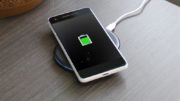Here’s an urban legend you might have heard. There’s a device you can plug into your phone’s headphone jack and it boosts your cell signal. It’s like an external antenna.
The problem of course, is that it’s a myth.
You may have seen devices like the one shown above. They are antennas, and they do plug into your phone’s headphone jack (if your phone has a headphone jack.) But they aren’t cellular antennas. They’re FM radio antennas.
FM… radio… antennas? How’s that?
That’s right. Most cell phones have FM radios built into them. Generally the radio chip that pulls in cell signals and interprets them is also capable of pulling in regular old radio broadcasts over a variety of frequencies. While this function is almost totally unused in the US and Canada, it’s common in other parts of the world for people to use their phones as radios.
This plug-in antenna helps cell phones pull in FM signals. Generally, radio broadcasts are on much lower frequencies than cell phone traffic. Lower frequencies mean you need a bigger antenna, so often times these devices extend out the way the antenna did on an old-school transistor radio.
Why doesn’t that same antenna help cell signals?
First of all it’s not designed to. There’s a direct connection to the built-in antenna and that connection doesn’t extend to the headphone jack. Second, it just isn’t necessary in most cases. As I said cell phone signals are in higher frequencies that don’t need a big long antenna. Even home cell boosters tend to use antennas that aren’t very long. A long extendable antenna is needed for low frequencies, not for higher ones.
Couldn’t they build it so it could work?
In the past, cell phones had extendable antennas and connectors for external antennas. People didn’t want that. They wanted super slim phones with hidden antennas. But if your phone did have a connector for an external antenna, you could connect it to some sort of amplifier. Realistically the market for something like this is so small compared to the number of phones made, it’s just not worth it for cell phone makers to do it.
At the same time, built-in cell antenna technology has gotten a lot better. You may remember the iPhone 4’s edge-mounted antennas and the scandal that erupted around them. The antennas were sensitive, but easy to short out on your hand. Today’s iPhones (and some Androids) use the same technology but now the antennas have a coating that keeps them from shorting out when touched. For the most part, there’s nothing an external antenna would do, that an internal antenna wouldn’t do just as well.
What about those people…
…who claim it works?
Folks, I don’t know what to tell you. Maybe for some people it does work, because they short out the headphone-jack-mounted antenna with their fingers. This would turn you into the antenna. Maybe they are imagining it. Maybe they’re just plain making it up. I don’t want to level accusations here.
The fact is, it’s not going to work for you. Just because a random person in the internet says it’s going to work for them, doesn’t mean it does. You probably found this article through research, and you’ve probably read a lot of other articles. Almost all of them agree… this method just doesn’t work.
What can you do to improve cell reception?
If you’re outside, there’s not much that you can do. You can get to higher ground or try to get closer to a cell tower. But if you’re inside or in a vehicle, you can get a cellular signal booster system from Solid Signal. This is real, proven technology that does work. It may not be as inexpensive as some of those fake solutions, but it’s real and it really helps.





